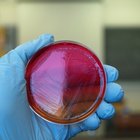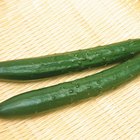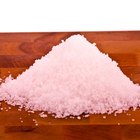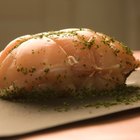
Most long-cured meats, including deli sausages, bacon and ham, are cured using small quantities of nitrites or nitrates. They're used for a number of reasons, primarily for their antibacterial properties. They also give cured meats their distinctive and appealing pink color. While many authorities say that the chemicals are safe when eaten as part of a balanced diet, there are government-imposed limits to the concentration that can be used in food, and some diners would rather avoid hams and other cured meats altogether. Amid the conflicting evidence as to the safety of nitrates and nitrites, one thing is certain -- boiling ham does not get rid of them.
Salts and Curing
Most domesticated animals produce large quantities of meat at slaughtering time. During the long centuries before refrigeration, preserving that meat for later use was a major preoccupation for farmers and cooks alike. Salt's value as a preservative is well known, bringing the life cycle of most microorganisms to a sudden halt. Over time, it became obvious that the impurities in some salts made them better than others for preserving meats. By the 19th century, scientists were able to identify those impurities as naturally-occurring nitrates and nitrites.
Nitrates and Nitrites
Many common vegetables, such as celery, naturally contain high quantities of potassium nitrate. It's also found in mineral deposits, where it's been known for centuries as saltpetre. In cured meats, hardy bacteria that can survive at high salt levels break down the nitrate into nitrite, which in turn provides protection against botulism and other dangerous forms of foodborne illness. After this discovery, many food manufacturers began using small amounts of refined nitrites, rather than saltpetre. However, the slow breakdown of nitrates into nitrites improves the flavor of many meats, so purified nitrates are still used in many curing mixtures.
Health Concerns
Research in the 1970s showed that under certain circumstances, nitrites could be transformed by heat into potentially carcinogenic nitrosamines. The U.S. Food and Drug Administration and the USDA's Food Safety and Inspection Service subsequently laid out strict limits on the use of nitrites and nitrates in cured meats. A report from the American Medical Association's Council on Scientific Affairs released in 2004 concluded that the levels of nitrites permitted in cured meats in the United States posed no health risk.
Boiling your Ham
As part of the curing solution, nitrites permeate your ham just as the salt, sugar and spices do. Boiling won't remove them, but it's still a beneficial cooking method because it reduces the quantity of sodium -- a more immediate health threat -- in your ham. Boiling your ham, or more accurately simmering it, gives wet-cured or "city" hams a firmer, more appealing texture. Dry-cured country hams are much saltier, and usually require soaking and then simmering before they're ready for table use. It also produces a rich ham broth, which can be used for soups or as a flavorful cooking liquid for vegetables.
Related Articles

Uses of Saltpeter in Food

What Is a Black Forest Ham?

The Effect of Salt on the Tenderness of ...
A Saltpeter Substitute for Curing Ham
How Long Do You Smoke Ham Per Pound?

How to Make Salt Brine

What Foods Provide Calcium D-Glucarate?

How Long Can You Cook Beef Ribs at 300 ...

How to Brine a Smoked Beef Brisket

Farm-to-Table Concept

Foods Containing Nitrates

Are the Nutrients Lost in Slow Cooking?

How to Use Sea Salt for Canning

Can I Substitute Salt Pork for Smoked ...

What Is Swallow's Nest Soup?
Can You Cook a Shank Ham in Boiling ...

How to Brine Pork Loins

The History of Smoking Meat

How to Brine a Ham With Sugar

The History of Flame-Retardant Clothing
References
- On Food and Cooking: The Science and Lore of the Kitchen; Harold McGee
- USDA Food Safety and Inspection Service: Ham and Food Safety
- American Medical Association: Report 9 of the Council on Scientific Affairs (A-04) -- Labeling of Nitrite Content of Processed Foods
Writer Bio
Fred Decker is a trained chef and prolific freelance writer. In previous careers, he sold insurance and mutual funds, and was a longtime retailer. He was educated at Memorial University of Newfoundland and the Northern Alberta Institute of Technology. His articles have appeared on numerous home and garden sites including GoneOutdoors, TheNest and eHow.
Photo Credits
Jupiterimages/liquidlibrary/Getty Images